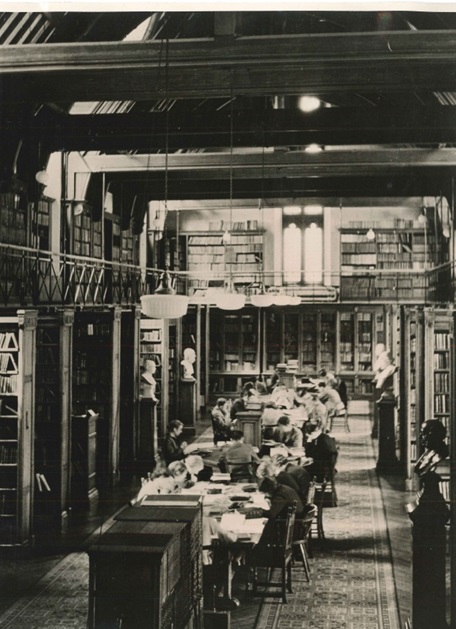The Slate Above the Tate
Posted on: 3 October 2022 by Kim Fisher, VG&M Visitor Services Team in 2022
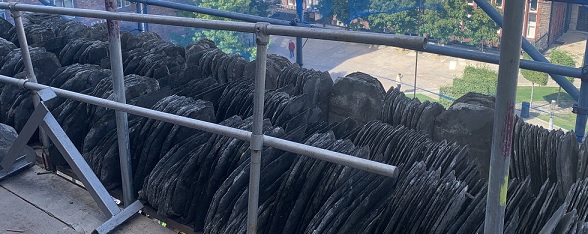
You may have noticed that our museum is temporarily closed. In this blog we take a look at the history of the Tate Hall Museum and also the current project to renovate the roof.
The First University College Library
The first library used by University College Liverpool students was based in the old converted asylum from 1882. As student numbers increased it became clear that the old building was not adequate and Principal Rendall’s Annual Report of 1887 drew attention to the fact that a new building must be erected:
“Every fragment of space, corridor or closet, heated or unheated has been pressured into service…Library books are stowed away in cupboards because there is no room for new shelves…”
It is thanks to many local businessmen and philanthropists that the new college building could be constructed and one of the main benefactors was Sir Henry Tate, the sugar refiner of Liverpool and London.
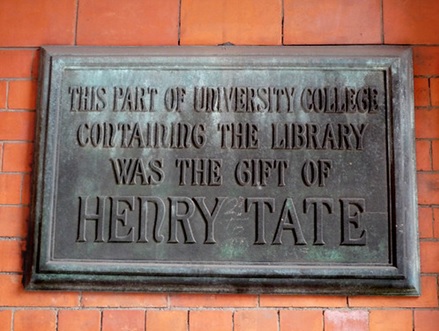
Plaque on the exterior of the Victoria Building commemorating Henry Tate’s donation for this section of the building.
The Tate Library
A large proportion of Sir Henry Tate’s donation went towards the construction of the Victoria Building, with around £16,000 going towards the Library block. Tate also had input into the design of the space; requesting oak flooring and fittings in the new library which cost a further £4000 and took the total cost for this section of the building to £20,000. This equates to almost 3 million pounds today.
Subsequently, the library was named the Tate Library with a bust of Tate positioned outside the entrance. This bust can now be seen in gallery 3 on our first floor.
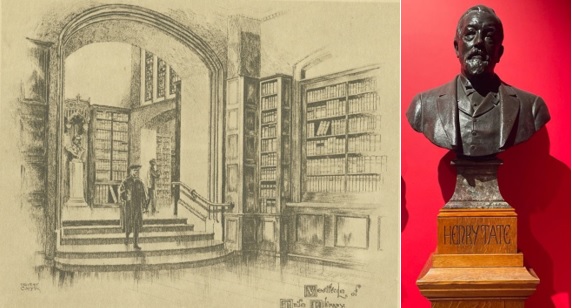
Left - Sketch of the original entrance to the Tate Library by Ernest Coffin, circa 1920. Right – the bust of Sir Henry Tate.
The purpose-built library was designed to hold 30,000 volumes and seat 80 readers and Principal Rendall stated that “The completion of the Victoria Building had completely changed the working conditions of student life.” However, within ten years of the building opening, complaints about the adequacy of the space soon started being mentioned in the student magazine. By 1903 the total library collection was around 40,000 volumes and the room was overcrowded with insufficient heating and lighting.
“… the lights becomes very dim. The electric light is turned on later but gives a wretched illumination. These things together with powerful drafts and in the cold conspire to render your attempts to work fruitless…if there were better light, fewer drafts and less approach to the temperature of a cellar, one might be able to work…” Student Magazine
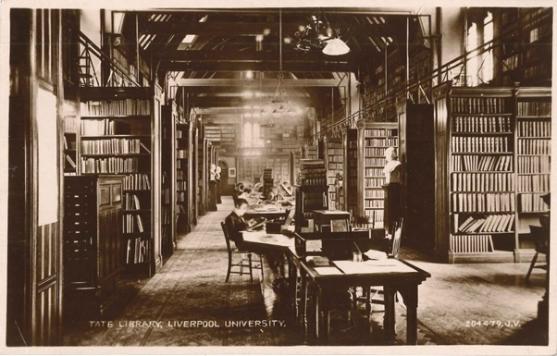
Extract from Sphinx Magazine and photograph of the Tate Library circa 1892
“The coldness and draughtiness are in themselves suffice to deter all but the hardiest from attempting to work there, while the appearance of the room at 4pm is a direct negative to our college motto ‘Fiat Lux’ (let there be light).” – Frustrated Reader
The Tate Library circa 1920 showing students seated in the dimly lit library surrounded by overflowing shelves.
The oak carved space was imposing and according to Kenneth Povey, the aesthetic quality of the room was responsible for its later inadequacy as a library space. From 1938 until his retirement in 1961 Povey served as librarian at the University of Liverpool. He stated; “A Library which looks as though it ought to contain good books creates a demand for them.” Donations and bequests rapidly increased and by the time complaints started to come in about congestion, the library could not physically expand any further.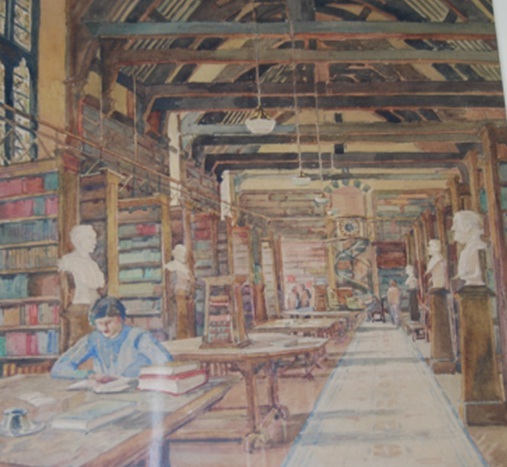
A painting of the Tate Library by Ethel Harker showing the spiral staircase leading up to the upper gallery, circa 1915.
Other drastic measures were taken to alter the interior space; the tall projecting bookcases were doubled and island cases were put in between the shelving, making the space feel even more cramped and dark. As a last resort, departmental libraries were set up to deal with the overflowing surplus of books and around 28 detached libraries were formed in other buildings over the years. The idea for one main library hub for all students to use had essentially failed.
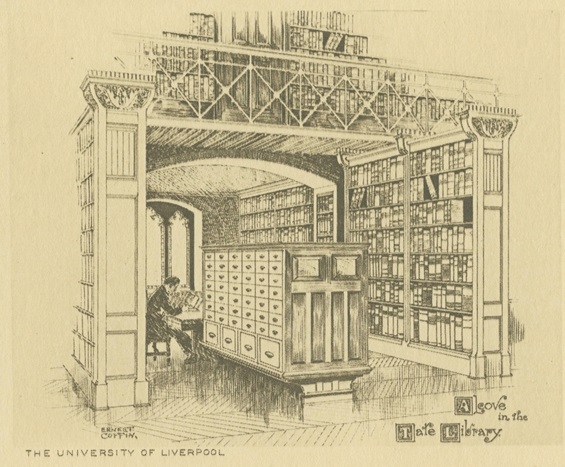
1920 sketch by Ernest Coffin showing the alcoves at the side of the library with overflowing shelves and large pieces of oak furniture.
However, when we look at student numbers for 1893 (415 students) compared to the 1938 (2,055 students) it is not surprising that this relatively small space could not accommodate the vast number of students and all of the books required by each department. The Victoria Building had initially been built to accommodate the Faculty of Arts and as the university expanded and other buildings were constructed, departments moved out of the building and the spaces constantly changed over the years to fit the needs of an evolving, growing university. This change in requirement also happened for the Tate Library.
A Room of Requirement
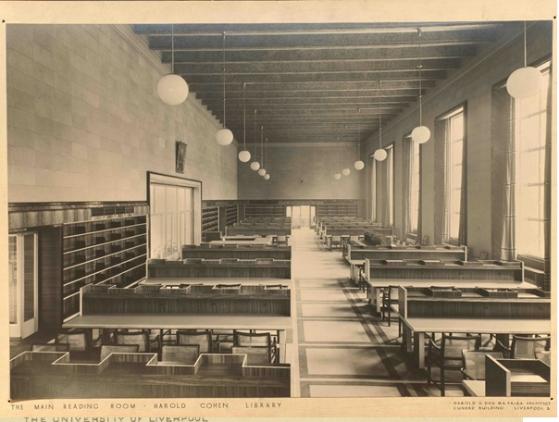
Interior of the Harold Cohen Library and main reading room circa 1938.
In 1938 the Harold Cohen Library had been opened opposite the Victoria Building and would accommodate 300 readers and 250,000 volume with the potential to expand to 400 readers and 750,000 if required.
By 1939 it was decided that the Tate Library would become a function space for the university and from April-May 1939 a report was provided by Lionel Budden, Professor of Architecture, on how improvements could be made to the Tate.
Budden commented that the room had very insufficient and uneven distribution of light due to the defects in design of the open roof and obtrusive tie beams and king posts which performed very little to the main structure. It was decided to remove these beams and add heraldic motifs to the corbels carrying the tie beams and one of the crests selected was the Tate family crest.
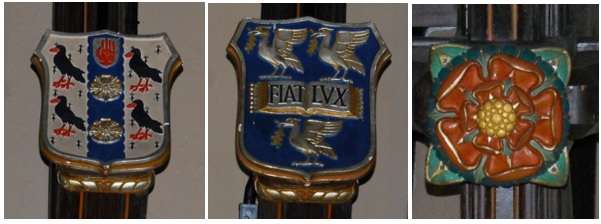
Left – Tate Family Crest, Middle – University of Liverpool Crest, Right – Red rose of Lancaster.
The electric lighting also needed to be reconfigured and the coloured stained-glass windows replaced to let in more natural light. The metal gallery that took library users to additional shelves in the roof alcoves was also removed because it was felt that it would no longer be required and would only detract from the proposed panelling and reduce the apparent height of the room.
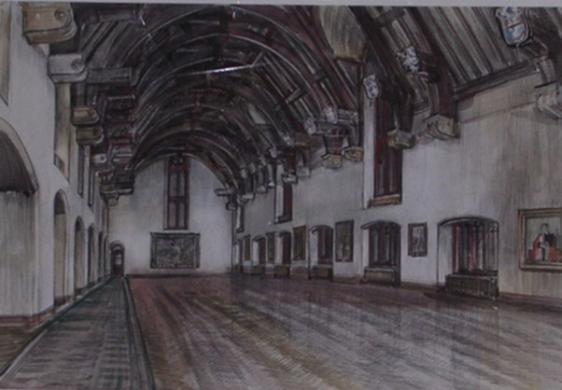
An empty Tate Hall circa 1970 with all library fittings removed.
Once the building works were completed, the space reopened as the Tate Hall and served as a space for receptions, meetings, art displays and examinations right up until around 2004. Many of our visitors who studied at the university come to visit the Tate Hall to relive their student days and how they felt during their examinations. Many express feelings of dread as they looked up to the imposing ceiling as the room took on a new meaning but still kept its ominous character.
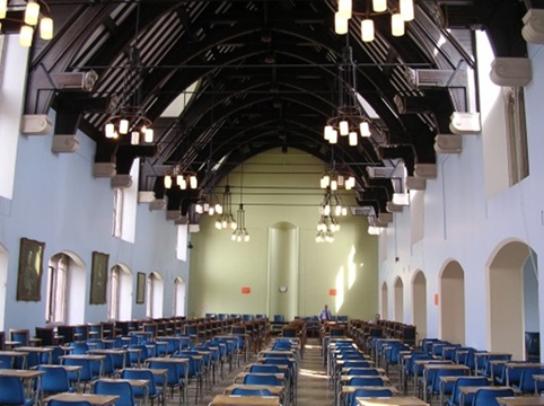
The Tate Hall used as an examination space circa 2004
The Tate Hall Museum
Discussions to transform the Victoria Building into a museum and gallery began in 2004 and construction work started on the building in 2006.
Designed to appeal to all groups ranging from schoolchildren, university staff and students to older people and tourists, the £8.6 million major refurbishment project involved renovation of the interior, exterior façade and landmark clock tower and the roof above the Tate Hall was patched up.
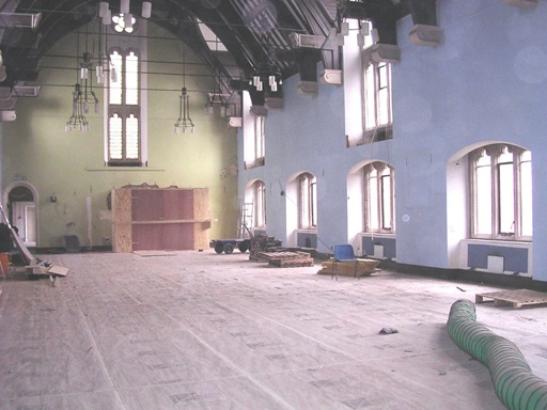
Tate Hall Building work in March 2007
In 2008 the Victoria Gallery and Museum opened to the public during Liverpool’s year as European Capital of Culture and the Tate Hall Museum was opened to the public. It is home to some of the more curious objects at the VG&M including items from various university departments that have been collected over the past 130 years. The exhibitions and displays in this space have ranged from the history of false teeth and a large dental display, collections centred around natural history, oceanography, archaeology, palaeontology and physics.
In 2020 staff noticed water ingress coming from the Tate Hall roof and all displays were subsequently protected during the global pandemic when the building was closed to the public. Building surveys were carried out by contractors and it was decided that the 130-year-old roof would need to be replaced.
All of our collections were removed from the space and the cabinets have been protected by wooden casing so that work could commence in summer 2022.
The Slate Above the Tate
The roofing project involves the removal and replacement of roof coverings, replacement of leadwork and repairs to chimneys and high-level terracotta.
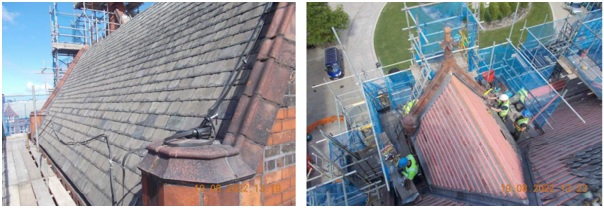
Work on the Tate Hall Roof, August 2022. Left – original tiles in place, right – tiles stripped and new felt and slates are being attached.
It was only once scaffolding was erected and contractors had access to these hard to reach areas that the full extent of the wear on the 130 year old roof became apparent. Although work only commenced a short while ago, repairs to areas like the central turret above the Tate Hall have already been completed. The before and after photograph of the turret below shows the craftsmanship that goes into the repair works on our Grade II listed building.
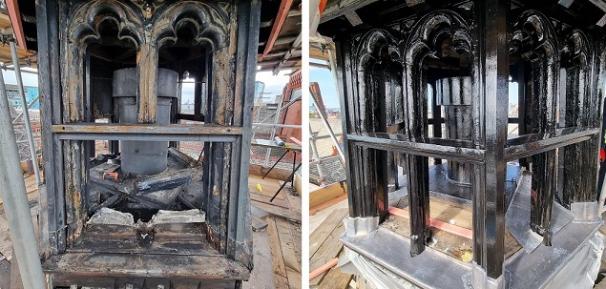
Repair work on the Tate Turret
The Tate Hall Museum is scheduled to re-open in 2024 and we will keep all of our visitors informed about the project on our social media channels and our website. Our first floor art galleries are open and you can view all of our exhibition content on our website.
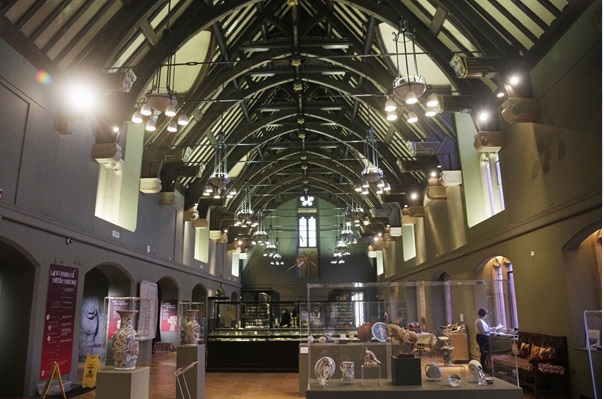
Tate Hall Museum, February 2020. The area on the left side of the photograph showing water ingress from the roof.
Keywords: Tate Hall Museum, Victoria Building, Alfred Waterhouse, Henry Tate, VG&M Renovation, University College Liverpool, University of Liverpool Library, University of Liverpool History, Museum, Roof.
